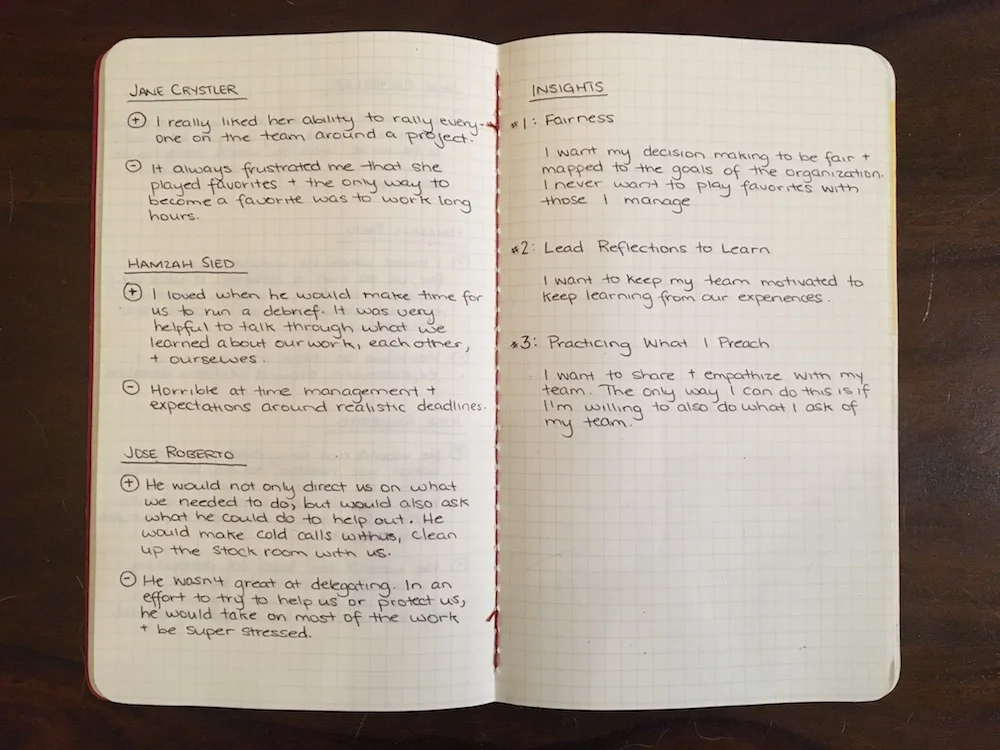Getting a promotion is a super exciting career moment—it’s a recognition and reward for all the hard work you’ve been putting in. It can also be an amazing opportunity to challenge yourself, learn and grow as a professional. However, being an expert in your discipline (whether it be marketing, design, accounting, etc.) can be a much different skill set from managing people.
The good news: anyone who’s willing to work at it, and accept the new role with some humility, has got a good chance of becoming the kind of boss that people actually appreciate and respect. Good bosses are not accidental—it’s those who choose to be intentional in their role that kick butt.
In this first post in our Learning How To Manage People series, I’ll walk you through three reflective exercises—similar to the ones we use with our clients—that’ll help you approach your new role with the purpose and intentionality needed to succeed. So, breakout a fresh notebook, your good writing pen and let the good boss reflection exercise begin!
Exercise 1: Reflect on Your Past Managers
Step 1: Create a List
Create a list of all the people in your past who have managed you. This list could include direct or indirect supervisors, coaches, teachers, counselors or mentors. Think back as far as you can—the more on your list, the better.
Step 2: Identify Behaviors
Once you've completed the list, take a look at the people on it and start to think about why they were effective in their roles. What did you respect about their style and the ways they effectively managed people? How did they make you and others feel? What did you and others observe in their behavior? Write down, next to each person, what made them an effective manager.
Now, look at your list again. This time, think about why these people were perhaps ineffective in their roles. What specifically didn’t work in how they managed people? How did this person make you and others feel? What did you and others observe in their behavior? Write down, next to each person, what made them an ineffective manager.
Note: You should have notes for both effective and ineffective behaviors for the same person. Remember, we’re talking about humans here and none of us are perfect.
Step 3: Draw Insights
Finally, look at your list and consider: what are the behaviors and qualities you’ve respected and admired in former managers? Perhaps, your notes highlight what you never want to do or how you never want to make someone else feel. The “so, what?” and where you take it is completely up to you.
Write down 2-3 insights you gained about the behaviors and qualities you’d like to emulate (or avoid) in your own management style.
For example, it could look something like this:
Exercise 2: Create an Intentional Manager Growth Plan
Step 1: Identify Your Strengths
Now it’s time to create an action plan! Make a list of all the things that you know you already do well as a person in charge of others. You might know what these things are because of past feedback or, perhaps, because experience has told you what works best. Write it all down. Then, star the top 3 things you do the best.
Step 2: Identify Your Areas of Growth
Make a list of three areas to focus on over the next three months. What are some opportunities for growth? Think about the needs of the job and the organization before you consider your own personal interests for growth. I typically suggest that two areas of growth be focused on the needs of the job and the organization, while the other area of growth be about your own interest in people management.
Note: If no one has given you any feedback about your strengths and opportunities for growth, ask your current supervisor for this information. You can show them your list (as it will show your ability to display high emotional intelligence), but ask them to be honest and push you to get better.
Step 3: Consider Your Past Managers
Look at your top three insights from the first exercise and consider how your strengths and opportunities for growth are connected to those reflections. Adjust your top three strengths and opportunities for growth if needed.
For example:
Strengths
- My positive attitude
- My ability to motivate people towards a common goal
- Finding ways to use humor when there is a situation of tension or conflict
Opportunity Areas
- Not being so visibly stressed. People know when I’m frustrated or stressed—and it can stress out other people.
- Scoping work: because I’m so optimistic (strength), it can get me into trouble when it comes to meeting deadlines. I never leave enough time to get something done and end up pushing deadlines later. I need to work on giving things more time.
Past Managers
- One supervisor told me that I needed to stop trying to be perfect. 80 per cent is good enough, especially when the project is a “nice to have” and not a need to have.
- Advice from another boss: Track your hours. Increase my ability to use data to influence my decision-making. I need to track things, collect information and add that to my decisions making process.
Exercise 3: Get Feedback from Those You Trust
Step 1: Identify Who You’d Like to Contact
Time to ask for help. Identify three people to reach out to whom you trust and are also currently managers. They could be a current or former colleague, an honest friend who knows you well, and/or a past boss (or “boss figure”). The key here is to contact individuals whose opinions you trust and that don’t make you feel psychologically unsafe—that will likely only make you feel judged and defensive.
Step 2: Make the Ask
Once you’ve identified those three individuals, reach out and let them know you’re stepping into a new role where you’ll be managing people and you’d love their help in becoming a more intentional manager.
Step 3: Conduct the Feedback Session
Assuming they say yes (of course they want to help!), here’s how I suggest you structure the feedback session:
- Share your top three insights from the first exercise and how you arrived at them. Then, from the second exercise, share your three strengths and three opportunities for growth.
- Ask for their feedback on your reflections. What do they think about them? And, what are some insights they can share from their experience starting as a new manager?
- Finally, ask if there’s anything else they would like to share.
Take notes during your calls. Review your notes and add any new insights, tips, tools and ideas to your Intentional Manager Growth Path.
Follow Your Intentional Manager Growth Path
It’s really easy to deprioritize working on yourself when the “to do list” is ever-growing and there seems to be no end in site. We’ve all been there!
However, it’s super important to not ignore what, perhaps, is your most important to do: bringing your best self to your team and organization every day.
So, how do you prioritize you? There are two tactics I recommend:
Ask Someone to Help You Stay Accountable
It doesn’t matter who this person is, it just matters that you stay accountable to your Intentional Manager Growth Path. The research in goal setting suggests an accountability buddy really does help.
So, choose someone who understands what you’re doing. Set deadlines, dates, reminders and figure out your communication strategies and expectations of each other to make it all happen.
Make Time for Reflection (And Do It!)
Craft out a small amount of time, try 15 or 30 minutes each week where you can reflect on your new role and compare how you’re performing against your Intentional Manager Growth Path. What feedback have you been given (director or indirect) that helps you know if you’re making movement on your growth path? The value of writing down goals and reviewing them often has been well studied and proven, so begin building this habit early in your management career.
Get Started
Good people don’t always make good managers. Good managers aren’t accidental, nor are they born “good at this.” Instead, they learn and work at it.
You are the only one who can truly invest in your own development, so start being the intentional manager and leader you wish to see in the world. The more deliberate you are in your own growth plan, the more likely you are to gain new insights into your own abilities and stretch yourself to become better worker, boss and human in the process.
So, what are you waiting for?
Stay tuned for the next post in our Learning How to Manage People series: Build Your Own Manager Toolkit.






